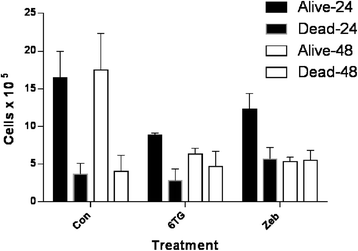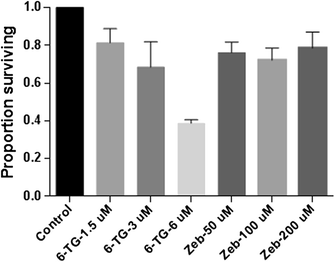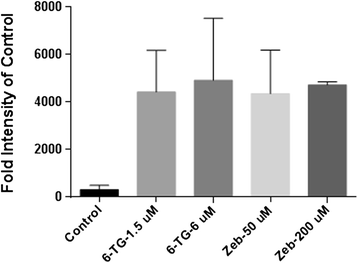6-Thioguanine and zebularine down-regulate DNMT1 and globally demethylate canine malignant lymphoid cells
- PMID: 25480665
- PMCID: PMC4272768
- DOI: 10.1186/s12917-014-0290-8
6-Thioguanine and zebularine down-regulate DNMT1 and globally demethylate canine malignant lymphoid cells
Abstract
Background: The antimetabolite 6-thioguanine (6-TG) has been used to treat both human and canine lymphoid malignancies. 6-TG has been shown to be epigenetically active as a demethylating agent in a human lymphoma cell line, causing downregulation of DNA methyltransferase 1 (DNMT1) through ubiquitin-targeted degradation. Zebularine (Zeb), a similar cytidine analog, also has demethylating activity as well as oral bioavailability. The hypothesis of the present study was that 6-TG and Zeb would cause downregulation of DNMT1 and globally demethylate the genomic DNA of canine lymphoma cells. The secondary hypothesis was that these agents would cause a dose-dependent decrease in cell proliferation in canine lymphoma cells. Canine CLGL-90 malignant T cells and CLL 17-7 cells were incubated in modified RPMI media. They were treated with 6-TG, Zeb, or control media at biologically relevant concentrations.
Results: Following treatment with each agent, DNMT1 protein and global DNA methylation were significantly decreased. A dose-dependent decrease in cell survival was also observed, with apoptosis being the primary mode of cell death in the CLGL-90 cell line.
Conclusions: These results confirm the demethylating action of 6-TG and Zeb in canine cells which is similar to that shown in human cell lines. Confirmation of this mechanism supports the clinical application of these compounds as demethylating drugs in veterinary patients.
Figures






References
MeSH terms
Substances
LinkOut - more resources
Full Text Sources
Other Literature Sources
Medical
Miscellaneous

